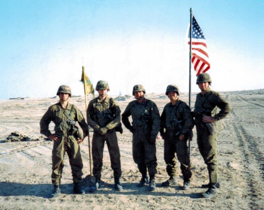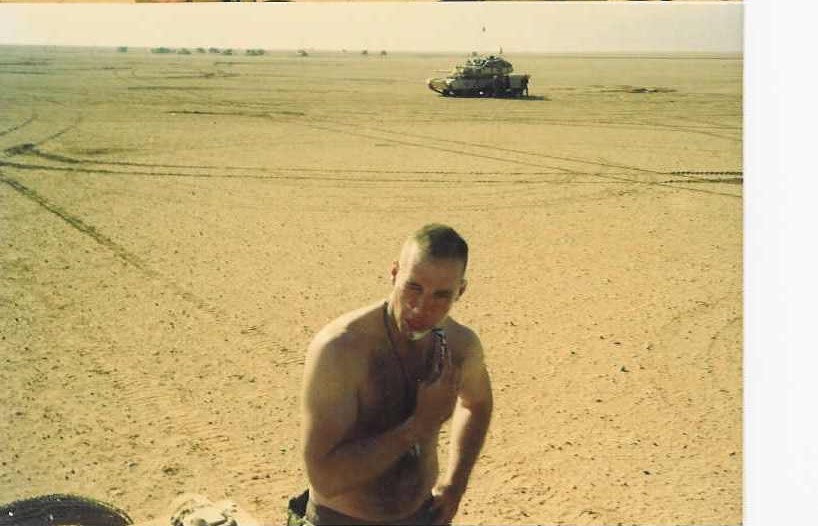
Ntl Guard veteran appreciates HVAF’s pantry & case managers for 14 years
February 24, 2021
HVAF named Best Place to Work in Indiana
February 25, 2021Desert Storm’s 30th Anniversary: Arne Pedersen

Thirty years ago, 24-year-old Arne Pedersen led his Tank Platoon into what would later be known as Desert Storm. Today, as a HVAF Board Member, he shares his perspective on the four-day war on his 30th anniversary:
DESERT STORM | DAY ONE:
“We were prepped and moved and in a holding pattern waiting for the field artillery to prep our first battlefield. And I am looking at all of this artillery going overhead… It looked like the ultimate fireworks display going overhead. It was incredible. And you could feel the whole ground rumbling when it hit.
After the ceasefire from our field artillery folks, we moved off and waited for our first battle. A lot of the tanks and first armored personnel carriers were destroyed so we just had a lot of light infantry left. And I remember going across our battlefield and we would take out whatever we needed to take out. We got to the end and they wanted to do one more sweep. As we were lining up for the sweep, I’m standing out at my hatch – in a position where an Iraqi infantryman with a rifle properly placed could shoot my head off. That was going through my mind as we were going across. But we had to go across the field and pay attention to what’s going on out there and everybody had to be trigger ready.
And I remember seeing a bunch of Iraqi soldiers getting behind this one bush in my sector. We stopped right at the bush and my tank gunner had the main gun pointed right at them… I’m up in the hatch, standing as tall as I can, I pull out my weapon and I point it down towards the bush and I yelled at the top of my lungs to get out. They come out, and they don’t have any weapons. I tell my loader to hand them MREs (Meals Ready to Eat) and water. We had already set aside MRE’s and water, that was a part of what we wanted to do.
And then we got the call to quickly move after that first engagement. We were moving really fast, in fact we moved so fast – we outran our supply line. We had to wait on them to get refueled.”
DESERT STORM | DAY TWO:
“Day two – we didn’t have a lot of action.”
DESERT STORM | DAY THREE:
“I remember earlier in the day, we stopped at the battalion because there was a stop order from the division. At that point in time, we had engagement from borders and from a couple of armored personnel carriers that the Iraqis had come in. We didn’t have any tanks just yet, and they started shooting at some of us. So we had to reorient and take those folks out and as soon as we took them out … we got another call and our entire battalion had to move quickly.
We got into position and I’m looking up and down the line for my hatch. And I’m leaning out – we had our entire brigade on line at this point. You are looking at roughly 180 tanks on line. And we had about 100 meters spread between tanks… This battle that is about to unfold has become the largest U.S. Army Armor battle in history. (Read more about the Battle of Medina Ridge here.)

Arne (far right) with Alpha Company Officers
After the Apache helicopters fired off, the Iraqi army started coming towards us. The rest was on us, it was tank on tank. We were all on line, we were looking downrange. You have a sector, you fire and then you reload and you’re looking for your next one in your sector … and we shot several rounds, trying to take these guys out.
There was a point where we needed to move forward. I remember this distinctly, there were several empty 55 gallon drums in the desert… If you have those, those are typically marked on a map for the field artillery so they can use that as a point to be able to go from that point to another point and be able to direct fire.
My platoon sergeant was asleep – because we were so tired and on no sleep. We were working on adrenaline. I yelled at the tank gunner, ‘Get that tank moving now!’ So he moved out… five seconds later, an artillery round landed exactly where his tank was at. That was the second scariest moment of my time in war.
The third time would be when we had a chance to really get after these guys in the ridge. We were shooting, shooting, shooting – they started firing directly at us. But they were falling short because they didn’t have the range that our tanks had. When we finally got the ceasefire, which was in the evening… we made it to a different artillery headquarters. I saw a couple of soldiers run down into a hole. I reported it and took my platoon and surrounded the hole. I had called it up and it went all the way up to the division level and then they sent in a couple of special operators that spoke Arabic. They told these guys, ‘you are completely surrounded, you need to come out. If you don’t, we’re going to blow up this entire bunker. Come out with your hands up, no weapons, white flag.’
It took about fifteen minutes or so, and then these guys came up. I didn’t get an order for ceasefire, and I didn’t give my order to my guys for ceasefire until after these guys got checked for weapons and any explosives they might have had on their body. Once I got the all-clear, then everybody relaxed. Then we got back into our formation and got refueled (and refilled on other supplies) so that we were ready to make our next movement.”
DESERT STORM | DAY FOUR:
“Our orders at that point in time were to go to Al Basrah. We were going to go into the town, and we were going to attack the town, and we were going to hold the town. That’s what they wanted us to do. We were all done, we were ready to go and then during the night as we were getting prepped and started to make our movement, we were told to stop. The ceasefire had already come from Washington, D.C – and it came all the way down.
The Iraqi Army knew they were going to get defeated, so they were trying to high tail it out of Kuwait. They were along a highway that was going through Al Basrah, that goes all the way to Baghdad. The highway was coined ‘The Highway to Hell’ because there were a lot of dead Iraqis, and vehicles and everything else were just blown apart. The next day we do a trip over our last battle so we could go look at the battlefield, because what we wanted to do was take a look.
The next order we got is that they moved us up a defensive line so we could protect what was going on with the Kuwaitis. The Iraqis had already started fires at oil wells, so there was smoke that filled the air. It was terrible. Our uniforms were OD (Olive Drab) green… you get all the smut from the burning oil wells, and they were turning black. That’s how bad it was.
Then we got an order to go back to the different sites and different defensive positions the Iraqis had built into the sand and we were to look for ammunition and we were to blow the ammunition source. I think this was probably the last big scariest moment of my time down there. I remember going down into a bunker, and we see everything and I think ‘Oh my gosh, this is terrible.’ You had to pour JP-8 (jet fuel) all over the ammunition. And I’m putting it up to the doorstep and I have one foot out of the door and I had to go up a flight of about eight desert steps. And I have to light a match and then jump. I land on the ground and there’s a big explosion and I remember my tank crew looked at me and were laughing at me. But I got to tell you, that was a bit scary!”
SOME HEARTBREAKING MOMENTS
And we continue to move our defensive line, and make sure everything was secure. During this time, this was probably the part that broke our hearts more than anything else – they didn’t want us to completely destroy Sadam’s army because Iraq would have just collapsed, and that’s not why we went there. We went there to liberate Kuwait – which we did in four days. And he started going to cities like Al Basrah with a strong Shiite stronghold. And Sadam and his guys were Sunnis, and the Shiites were going to rebel, and he went to go put that rebellion down and just shot them up. It was a massacre – they had nothing to protect themselves. They thought that we were going to go in and back them up. And we didn’t do that because we didn’t have orders to do that. And we had to stand by, we knew it was happening and we couldn’t do anything about it.
I still remember into the north, Kurd had the same problem. And again – nothing we could do. Nobody could do anything about it. We had to let Sadam do what he did – I mean it was brutal, BRUTAL, what that guy did.
TURNING 25 DURING THE GULF WAR
“I turned 25 in the desert. And this is three weeks after ceasefire, and there was a local family with a bunch of their sheep and camel, and we gave them food and water. They wanted to give us a lamb and wouldn’t leave unless they gave us a lamb – and this happened to be on my birthday. It just so happens the guy who was my wingman, before he enlisted in the Army, he was a cowboy out west and had experienced slaughtering livestock. And one of my fellow platoon leaders’ tank gunner was a trained chef from New Orleans. I told my commander since it’s my birthday and we have these two guys, we are going to take one of the grates off of the tanks and build a fire and cook it. My commander looked at me and said, ‘just make sure nobody gets sick!’
I had fresh lamb for my birthday dinner, and I had gotten a box of cigars in the mail. I had a cigar to finish that meal off. That was a great day!”
THE END OF THE JOURNEY

Arne was able to shave when he took his first shower as well. “Everything that I have here is posh compared to my life in the desert,” Arne said.
“We did not have shower facilities. We had purchased on the Economy in Germany some makeshift showers that you could use in the field. We didn’t set anything up until we knew we were going to stay long enough. We were at that point in time, and I got my first shower in eight weeks!”
We stayed out there for four more weeks, still in all of the soot. And we are breathing all of this in. And we now had sand flies as it was starting to warm up and they would bite. We were in a position where I would say nobody wanted to be.
We made our way back into Saudi Arabia in mid-April. We had a long track to get back and it was hard. We had our tank engines go down because a grain of sand would get in them. I led a group of 12 tanks that were getting towed. One time, the heat hit the ammunition rounds that was stored inside the gun turret. And I remember the panels blew out and we had all of this fire coming out of this one tank. The flames were all of the gunpowder, which was kind of scary! Nobody got hurt – thank God.
Then we were able to go to King Khalid Military Center. Our tanks were turned in – and we drew new tanks. Then we prepped those tanks, and those went to the port and they were shipped to Germany. We were there in tents for another week and then they put us on civilian planes.
I remember getting back to Germany and the company wives had put together a nice welcome home for us. We didn’t lose any soldiers – thank God. I was very, very pleased about that.
LESSONS LEARNED
- Don’t ever take your training for granted.
- If somebody has combat experience, don’t ever, ever tell them they don’t know what they are doing. That is not a good thing to do.
(I always kept that in the back of my mind in future units when I trained soldiers who had been in war. I already had been in their shoes – and wanted to make sure they felt welcomed.)
- Learning how to apply Just War Theory: reasons on why you should go to war, how to prepare for war, and win the war à de-escalation and return to normalcy.
EFFECTS OF DESERT STORM/GULF WAR
“We experienced Gulf War syndrome. I remember being stationed stateside afterwards in 1992, and the unit that I took over – half of that unit were Desert Storm veterans like myself and of those, a handful of them had different issues. Clouds in the lungs, issues with skin, shrapnel in feet, etc. It’s all a matter of perspective and really understanding the totality of war.
Anybody that goes to war … will have some sort of PTSD. It’s a natural reaction to an abnormal situation. We were not created to go to war. And most people do not have severe cases of PTSD, but they do have it for the rest of their life – I am one of those. But there are some people who have severe PTSD, and some of those are HVAF veterans.
I have carried over an extreme amount of discipline in what I do and how I act and how I talk. My transition from active duty to civilian life was a challenge, and it’s a challenge for every veteran. I was around people that understand discipline, focus, and execution 24/7 – and that is not civilian life. It’s much different.”
INVOLVEMENT WITH HVAF
I learned on active duty that leaders take care of soldiers, and that is why I have been on the Board of Directors with HVAF for almost 13 years now. I want to make sure soldiers get taken care of. I don’t want to see them hurt, or living below (poverty level). It does hurt to see those out living underneath bridges when they don’t have to.
From the founding of our country, George Washington wanted to make soldiers got pension, land, and were taken care of. The very first Commander-in-Chief thought that way, why shouldn’t I feel that way?
FINAL THOUGHTS
There was great political leadership from the president at the time: George H.W. Bush. He did the right things. We had the right generals – Colin Powell was a great chairman of the Joint Chief of Staff. They got the right Four-Star Generals to be the officers in charge of the whole operation. We really focused in on executing and doing things right.
The logistics that we did were amazing, and at the time had never been undertaken. We brought in 500,000 troops to Saudi Arabia in six months – which is huge! We executed that mission flawlessly. We partnered with a lot of countries in the Middle East to do what we did. Some countries sent supplies, some sent money. It was a global effort to liberate Kuwait.

